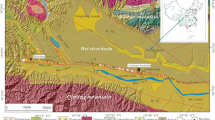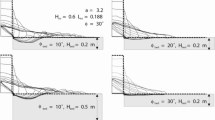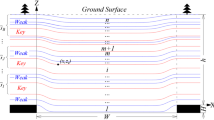Abstract
A procedure is developed for predicting surface subsidences based on the linear viscoelasticity theory. A four-parameter curve is accepted as a creep function to describe the process of movement. Proceeding from in situ data on surface subsidences, unified rheological indices are defined for all potassium strata of the Upper Kama deposit. The prediction method shows effect of filling on movement and makes it possible to model numerically and estimate the change in movement trough in time.
Similar content being viewed by others
REFERENCES
G. Kratch, Movement of Rocks and Safety of Undermined Constructions [in Russian], Nedra, Moscow (1978).
S. G. Avershin, Rock Movement in Underground Mining [in Russian], Ugletekhizdat, Moscow (1947).
D. A. Kazakovskii, Mining-induced Surface Movement [in Russian], Ugletekhizdat, Moscow — Kharkov (1953).
V. Budrikh, E. Litvinishin, S. Knote, and A. Salustovich, Calculation of the Mining-induced Surface Movements [in Russian], Ugletekhizdat, Moscow (1956).
M. A. Iofis and A. I. Shmelev, Engineering Geomechanics in Underground Mining [in Russian], Nedra, Moscow (1985).
A. D. Sashurin, Rock Movement in Mines of Ferrous Metallurgy [in Russian], IGD UrO RAN, Ekaterinburg (1999).
A. G. Shadrin, Theory and Calculation of Rock and Surface Movements [in Russian], KGU, Krasnoyarsk (1990).
Guideline on Flooding Safety in Mines and Undermined Construction Protection in the Upper Kama Potash Deposit [in Russian], Saint Petersburg (2004).
Yu. N. Rabotnov, Elements of the Hereditary Mechanics of Solids [in Russian], Nauka, Moscow (1977).
M. A. Koltunov, Creep and Relaxation [in Russian], Vyssh. Shk., Moscow (1976).
F. Wossermen, Neural Computing Engineering. Theory and Practice [Russian translation], Mir, Moscow (1992).
A. A. Baryakh, “An approach to predict time-changes in stress-strain state of undermined rock mass,” in: Proceedings of the Scientific Session on Strategy and Processes of Developing the Georesources, 2003 [in Russian], GI UrO RAN, Perm (2004).
B. Z. Amusin and A. M. Lin'kov, “Method of variable moduli for solving one class of linear hereditary creep problems,” Mekh. Tverd. Tela, No. 6 (1974).
O. Zienkiewicz, The Finite-Element Method [Russian translation], Mir, Moscow (1975).
Author information
Authors and Affiliations
Additional information
__________
Translated from Fiziko-Tekhnicheskie Problemy Razrabotki Poleznykh Iskopaemykh, No. 4, pp. 26–34, July–August, 2005.
Rights and permissions
About this article
Cite this article
Baryakh, A.A., Telegina, E.A., Samodelkina, N.A. et al. Prediction of the Intensive Surface Subsidences in Mining Potash Series. J Min Sci 41, 312–319 (2005). https://doi.org/10.1007/s10913-005-0096-y
Received:
Issue Date:
DOI: https://doi.org/10.1007/s10913-005-0096-y




